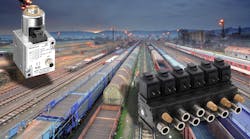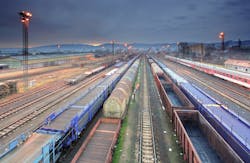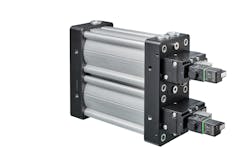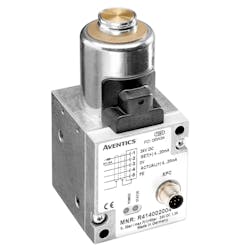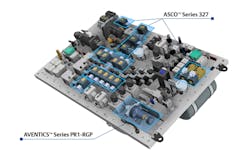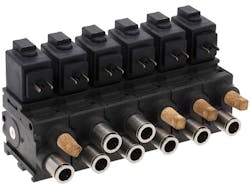Selecting Standard-Compliant Pneumatics for Railway Applications
Content has been updated as of Oct. 13, 2021.
At a glance:
- While durable, sophisticated pneumatics technology is key for OEMs to successfully face the extreme conditions of the railway industry, they also need expert partners who know railway standards inside and out.
- Fire protection, electromagnetic compatibility of components, and climate conditions such as pressure and humidity are important safety considerations.
- Some applications for rail pneumatics include door operation, suspension and leveling, brake control and water management.
As the railway industry evolves in response to globalization, digitalization and climate change, it faces new challenges. In order to solve them, the technology used in rail transport must develop too. However, as products change, they must meet stringent national and international safety requirements. Many of these products are pneumatic components and systems to control various functions on passenger and freight trains.
To overcome the latest industry challenges successfully, rail OEMs must implement effective, future-proof pneumatic systems that meet all railway standards. Railway compliant pneumatic components must fulfill the highest safety requirements and toughest industry demands across a wide range of applications.
Tracking Industry Standards
Many national and international regulations set the foundation for rail safety and successful innovations. OEMs that want to effectively and efficiently launch new products must keep track of and comply with them all. But as globalization creates new sales markets with different requirements, that can prove to be quite challenging.
Here are a few important standards for pneumatic components, many of which apply to both the European and Asian markets.
EN 50155
Railway Applications–Rolling Stock–Electronic Equipment
This standard explains the requirements for electronic components. The mechanical tests are also applied to solely mechanical solutions (e.g., shock and vibration, climate, etc.).
EN 45545
Railway Applications–Fire Protection on Railway Vehicles
This is the European standard to define requirements for fire behavior of materials and components.
EN 50126
Railway Applications–The Specification and Demonstration of Reliability, Availability, Maintainability and Safety (RAMS)
This standard specifies how to assess and define system safety, reliability and related life cycle costs.
EN 15085
Railway Applications–Welding of Railway Vehicles and Components
This standard defines procedures and quality measures for design and production of welded components in railway.
TSIs (Technical Specifications for Interoperability)
These are European Commission regulations concerning technical specifications for interoperability of subsystems for the European Union rail system.
DIN 6701
Adhesive Bonding of Railway Vehicles and Parts
This standard defines procedures, quality measures for design and production of adhesive bonded materials.
In addition to these standards, railway components must be able to cover voltage tolerances of +25% to −30%, achieve an IP protection class of typically IP65 (EN 60529) or higher and endure humidity of at least 95% for 30 consecutive days.
Pressures between 2 and 10 Bar and nominal voltages of 24 to 110 V DC for pneumatic components usually apply. The drop-out voltage must be higher than 10% of the nominal voltage, especially in braking applications, and only negligible leakage is allowed at low temperatures.
Selecting Components for Safe, Heavy-Duty Operation
Compliance with safety requirements is part of what makes railways one of the world’s safest means of transportation. Selecting highly reliable, quality components and systems is central to protecting people and property on board as well as avoiding downtime and repair costs.
Fire protection is fundamental for safe operation. All potentially flammable products must cover appropriate fire protection properties to ensure effective protection. In Europe, all products and systems must meet the EN 45545 series of standards, while in the U.S., NFPA 130 fire protection regulations apply.
Another safety concern is the electromagnetic compatibility of components, governed by EN 50121-3-2. This EMC Directive is also part of the EN 50155 and defines limits and measurement methods for electromagnetic emission and immunity to interference for all types of railway vehicles and their electric components.
The climatic conditions of railway vehicle operation add another layer of safety complexity. Components used must be sufficiently shock- and vibration-resistant. Pneumatic components are usually subject to shock and vibration tests according to EN 61373, category 1 or 2, depending on where and how they are installed. Tests are expanded to include environmental conditions, typically defined in EN 50155, the standard for electronic equipment on rolling stock.
Implementing Compliant Pneumatic Railway Applications
Since the air brake was invented more than 150 years ago, compressed air has played a major role in the railway industry. Today, pneumatic components are used in a wide range of applications in both passenger and freight vehicles. For successful product development, OEMs must implement pneumatic applications that meet the highest safety requirements and industry demands. Outlined below are a few of the many applications and compliant solutions.
Compressed Air Preparation
Nearly everywhere in the world, compressed air must be processed in accordance with ISO 8573-1 and its required cleanliness classes. A high-quality supply of compressed air ensures all pneumatic components and systems on board function perfectly. Appropriate levels of pressure, air dryness and air purity are critical for compliance and reliable operation.
In order to achieve this level of purity, powerful filtration removes dirt particles to less than 5 micron and compressor oils from compressed air, while air dryers with advanced absorption technology remove moisture quickly and efficiently.
Bottom Discharge Door
Unloading bulk cargo from freight cars is a tough job that requires proven components with robust designs. They ensure that bottom discharge doors can reliably open and close when needed.
Look for heavy-duty cylinders and valves that are tested to the required specifications and related control valves specifically designed for outdoor applications. These can stand up to freight transport’s severe operation environment. For a convenient, time-saving solution, there are ready-to-install products with corresponding accessories, such as tubing, filters and stainless-steel fittings that can be used at temperatures of up to 80°C.
Suspension and leveling
Complex applications that affect safety, such as controlling bogie suspension bellow pressure for height control, require proportional pressure control valves. They form a ready-to-install levelling control system with solenoid valves, regulators, pressure switches and wear-free height sensors, simplifying installation and saving time compared to individual components.
The electronically controlled air suspension ensures the exact entry and exit height of the vehicle, which facilitates quick boarding. Control electronics assure height accuracy, while cutting air consumption in half. Designed in protection class IP66, the complete solution is protected against water and dust and is suitable for all climate zones, covering a temperature range of −40°C to 70°C.
Brake Control
Completely configured pneumatic control manifolds can be used to adjust the brake pressure on trains. They are matched to the respective assembly and brake performance specification and are appropriate for the pneumatic service, emergency and parking brake. Modern braking systems frequently use proportional control valves for more accurate brake pressure control.
Internal and External Doors
High-speed trains travel at speeds of up to 350 km/h. Reliable external doors and the fast-switching valves that open, close and lock them are vital for the safety of everyone on board. Direct acting poppet valves together with special door cylinders for safe operation, including preset cushioning and speed customized for the door weight and kinematics, are used to offer optimum performance combined with reliable anti-trap protection.
Nose Cone and Coupling
Like internal and external doors, proven assemblies consisting of railway-compliant control valves and heavy-duty cylinders operate nose cones as well as the coupling mechanisms on trains. Compact, light-weight valve manifold solutions or individual components can be used to fulfill the desired coupling function. Because of the harsh environments these applications face, it’s important to look for cylinders with high-performance special wiper seals and scrapers at the piston rod to reliably remove dirt and ice, and to use limit switches designed for extreme environments.
Toilet Control and Water Management
The potential of a direct operated poppet valve is often underestimated, but 3/2 poppet valves specifically designed for the railway industry prove their advantage on toilet and water applications. The valves control different functions of vacuum toilets, fresh water supply and grey water applications on trains, combining a compact size with high reliability and assuring comfort at all times.
To make this application compliant and as comfortable as possible, look for robust poppet valves that have been tried and tested in practice, are shock- and vibration-resistant and meet fire protection requirements according to EN 45545.
Partnering with Compliance in Mind
While durable, sophisticated pneumatics technology is key for OEMs to successfully face the extreme conditions of the railway industry, they also need expert partners who know railway standards inside and out. In order to apply the many different railway standards and comply with their specification, it’s important to look for a supplier that has a high degree of product expertise and in-depth knowledge of the railway industry, as well as a comprehensive, compliant pneumatics portfolio.
Robust pneumatic railway components set the benchmark for quality and functionality. They meet the exceptionally high demands of the railway industry and improve application performance, safety and reliability. Using pneumatic components that comply with all applicable standards ensures an OEM’s long-term success in railway product development.
Frank Gevers is director, railway, fluid control and pneumatics at Emerson. With a degree in mechanical engineering from the University of Applied Sciences, Cologne, he has been involved in the railway industry for nearly 15 years.
